Colosseum › Artillery in Medieval Europe » Ancient origins
Articles and Definitions › Contents
- Colosseum › Antique Origins
- Artillery in Medieval Europe › Ancient History
Ancient civilizations › Historical and archaeological sites
Colosseum › Antique Origins
Definition and Origins
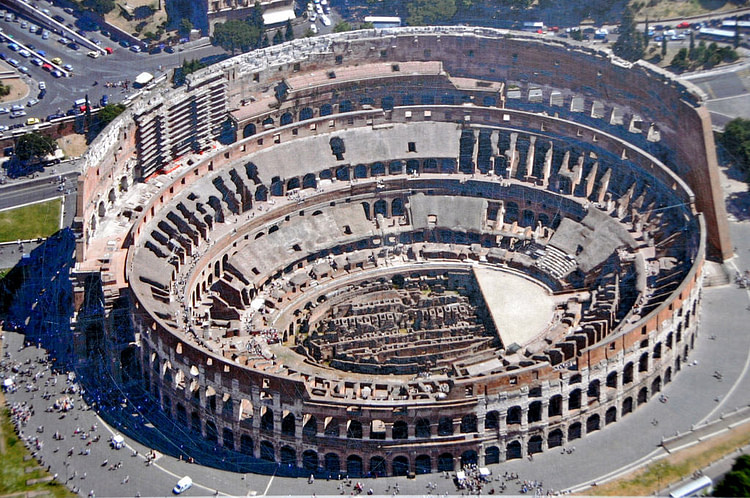
The Colosseum or Flavian Amphitheatre is a large ellipsoid arena built in the first century CE under the Roman emperors of the Flavian dynasty: Vespasian (69-79 CE), Titus (79-81 CE) and Domitian (81-96 AD). The arena was used to host spectacular public entertainment events such as gladiator fights, wild animal hunts and public executions from 80 CE to 404 CE.
PURPOSE & DIMENSIONS
The construction of the Colosseum was begun in 72 CE in the reign of Vespasian on the site that was once the lake and gardens of Emperor Nero ’s Golden House. This was drained and as a precaution against potential earthquake damage concrete foundations six metres deep were put down. The building was part of a wider construction programme begun by Emperor Vespasian in order to restore Rome to its former glory prior to the turmoil of the recent civil war. As Vespasian claimed on his coins with the inscription Roma resurgens, the new buildings --the Temple of Peace, Sanctuary of Claudiusand the Colosseum-- would show the world that 'resurgent' Rome was still very much the centre of the ancient world.
The Flavian Amphitheatre (or Amphiteatrum Flavium as it was known to the Romans) opened for business in 80 CE in the reign of Titus, Vespasian's eldest son, with a one hundred day gladiator spectacular and was finally completed in the reign of the other son, Domitian. The finished building was like nothing seen before and situated between the wide valley joining the Esquiline, Palatine and Caelian hills, it dominated the city. The biggest building of its kind, it had the following features:
- four stories.
- a height of 45 metres high (150 feet).
- a width of 189 x 156 metres.
- an oval arena measuring 87.5 m by 54.8 m.
- a roofed awning of canvas.
- capacity for 50,000 spectators.
The theatre was principally built from locally quarried limestone with internal linking lateral walls of brick, concrete and volcanic stone (tufa). Vaults were built of lighter pumice stone. The sheer size of the theatre was the possible origin of the popular name of Colosseo, however, a more likely origin may have been as a reference to the colossal gilded bronze statue of Nero which was converted to resemble the sun-god and which stood outside the theatre until the 4th century CE.
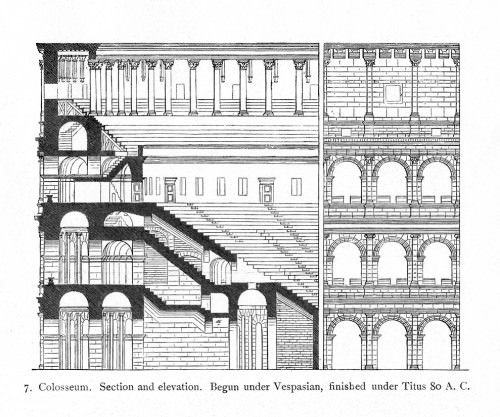
Colosseum Cross-Section
ARCHITECTURE
The theatre was spectacular even from the outside with monumental open arcades on each of the first three floors presenting statue-filled arches. The first floor carried Doric columns, the second Ionic and the third level Corinthian. The top floor had Corinthian pilasters and small rectangular windows. There were no less than eighty entrances, seventy-six of these were numbered and tickets were sold for each. Two entrances were used for the gladiators, one of which was known as the Porta Libitina (the Roman goddess of death) and was the door through which the dead were removed from the arena. The other door was the Porta Sanivivaria through which victors and those allowed to survive the contests left the arena. The final two doors were reserved exclusively for the Emperor's use.
Inside, the theatre must have been even more impressive when the three tiers of seats were filled with all sections of the populace. Encircling the arena was a wide marble terrace ( podium ) protected by a wall within which were the prestigious ring-side seats or boxes from where the Emperor and other dignitaries would watch the events. Beyond this area, marble seats were divided into zones: those for richer private citizens, middle-class citizens, slaves and foreigners and finally wooden seats and standing room in the flat-roofed colonnade on the top tier reserved for women and the poor. On top of this roof platform sailors were employed to manage the large awning ( velarium ) which protected the spectators from rain or provided shade on hot days. The different levels of seats were accessed via broad staircases with each landing and seat being numbered. The total capacity for the Colosseum was approximately 45,000 seated and 5,000 standing spectators. One of the oldest depictions of the Colosseum appeared on the coins of Titus and shows three tiers, statues in the upper external arches and the large column fountain - the Meta Sudans - which stood nearby.
EMPERORS TITUS AND CLAUDIUS WERE NOTED FOR SHOUTING AT THE GLADIATORS FROM THEIR SEATS IN THE COLOSSEUM.
The scene of all the action --the sanded arena floor-- was also eye-catching. It was often landscaped with rocks and trees to resemble exotic locations during the staging of wild animal hunts ( venatiories ). There were also ingenious underground lifting mechanisms which allowed for the sudden introduction of wild animals into the proceedings. On some occasions, notably the opening series of shows, the arena was flooded in order to host mock naval battles. Under the arena floor (and visible to the modern visitor) was a maze of small compartment rooms, corridors and animal pens.
GAMES & SHOWS
Although historically tied to earlier Etruscan games which emphasised the rites of death, the shows in the Roman arenas were designed simply to entertain, however, they also demonstrated the wealth and generosity of the Emperor and provided an opportunity for ordinary people to actually see their ruler in person. Emperors were usually present, even when they had no particular taste for the events such as Marcus Aurelius. Titus and Claudius were noted for shouting at the gladiators and other members of the crowd and Commodus himself performed in the arena hundreds of times. One vestige of the earlier Etruscan tradition continued, however, with the presence of the attendant whose job was to finish off any fallen gladiator by a blow to the forehead. This attendant wore the mythical costume of either Charon (the Etruscan minister of Fate) or Hermes, the messenger god who accompanied the dead down to the underworld. The presence of the Vestal Virgins, the Pontifex Maximus and the divine Emperor also added a certain pseudo-religious element to the proceedings, at least in Rome.
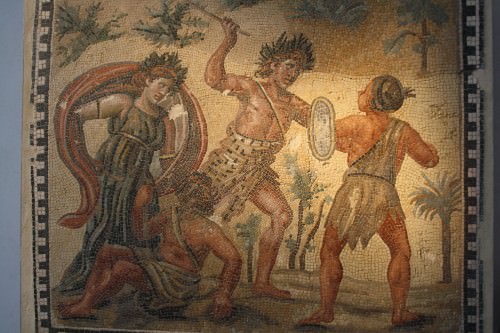
Roman Mosaic
However, blood sports and death were the real purpose of the spectacular shows and an entire profession arose to meet the massive entertainment requirements of the populace - for example under Claudius there were 93 games a year. Spectacles often lasted from dawn till nightfall and the gladiators usually kicked-off the show with a chariot procession accompanied by trumpets and even a hydraulic organ and then dismounted and circled the arena, each saluting the emperor with the famous line: Ave, imperator, morituri te salutant! (Hail, Emperor, those who are about to die salute you!).
Comic or fantasy duels often began the day's combat events, these were usually fought between women, dwarfs or the disabled using wooden weapons. The following blood sports between various classes of gladiators included weapons such as swords, lances, tridents, and nets and could also involve female combatants. Next came the animal hunts with the bestiarii -- the professional beast killers. The animals had no chance in these contests and were most often killed at a distance using spears or arrows. There were dangerous animals such as lions, tigers, bears, elephants, leopards, hippopotamuses and bulls but there were also events with defenceless animals such as deer, ostriches, giraffes and even whales. Hundreds, sometimes even thousands of animals, were butchered in a single day's event and often brutality was deliberate in order to achieve crudeliter -- the correct amount of cruelty.
Under Domitian, dramas were also held in the Colosseum but with a bloodthirsty realism such as using real condemned prisoners for executions, a real Hercules was burned on a funeral pyre and in the role of Laureolus a prisoner was actually crucified. The Colosseum was also the scene of many executions during the lunch-time lull (when the majority of spectators went for lunch), particularly the killing of Christian martyrs. Seen as an unacceptable challenge to the authority of Pagan Rome and the divinity of the Emperor, Christians were thrown to lions, shot down with arrows, roasted alive and killed in a myriad of cruelly inventive ways.
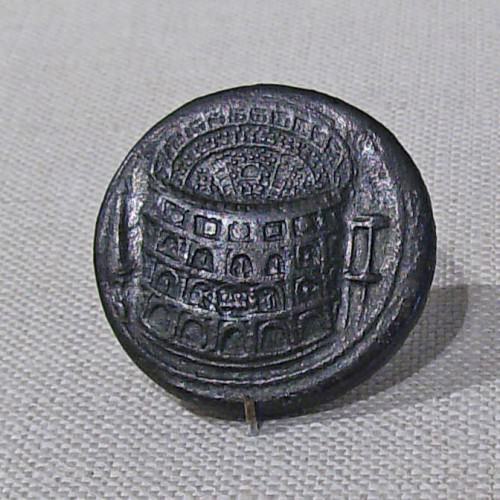
Bronze Sestertius with Colosseum
LATER HISTORY
In 404 CE, with the changing times and tastes, the games of the Colosseum were finally abolished by Emperor Honorius, although condemned criminals were still made to fight wild animals for a further century. The building itself would face a chequered future, although it fared better than many other imperial buildings during the decline of the Empire. Damaged by earthquake in 422 CE it was repaired by the emperors Theodosius II and Valentinian III. Repairs were also made in 467, 472 and 508 CE. The venue continued to be used for wrestling matches and animal hunts up to the 6th century CE but the building began to show signs of neglect and grass was left to grow in the arena. In the 12th century CE it became a fortress of the Frangipani and Annibaldi families. The great earthquake of 1231 CE caused the collapse of the southwest facade and the Colosseum became a vast source of building material - stones and columns were removed, iron clamps holding blocks together were stolen and statues were melted for lime. Indeed, Pope Alexander VI actually leased the Colosseum as a quarry.Despite this crumbling away though, the venue was still used for the occasional religious procession and play during the 15th century CE.
From the Renaissance period both artists and architects like Michelangelo and later tourists on their Grand Tour took a renewed interest in Roman architecture and ruins. As a consequence, in 1744 CE Pope Benedict XIV prohibited any further removal of masonry from the Colosseum and consecrated it in memory of the Christian martyrs who had lost their lives there.This, however, did not stop locals using it as an animal stables and its neglect is reflected in the curious work of Richard Deakin who in 1844 CE catalogued over 420 plant varieties thriving in the ruin, some rare and even locally unique -- perhaps originating from the food given to the exotic animals all those centuries before. The 19th century CE did, though, begin to see the fortunes of the once great amphitheatre improve. The Papal authorities sought to restore parts of the building, notably the east and western ends, with the latter being supported by a massive buttress. Finally, in 1871 CE the Italian archaeologist Pietro Rosa removed all of the post-Roman additions to reveal, despite its degradation, a still magnificent monument, a poignant and enduring testimony to both the skills and the vices of the Roman world.
Artillery in Medieval Europe › Ancient History
Ancient Civilizations
Artillery weapons in medieval Europe included the mounted crossbow (ballista) and single-arm torsion catapult (mangonel), both similar to ancient Roman machines. As armies battled further afield such as in the Byzantine Empire and against the Arab caliphates, in particular, so new ideas spread from China and India across Eurasia and into western Europe. The trebuchet arrived from the late 12th century CE, which was similar to the mangonel but used a counterweight as a means to propel missiles further and with greater accuracy. Used by both attackers and defenders during siege warfare, batteries of artillery caused devastation to people and fortifications. Cannons were used from the 13th century CE, and although they were highly dangerous to use and largely ineffective because of their lack of accuracy, by the 15th century CE, technology had improved dramatically. Gunpowder-projected missiles of all sizes became the norm, finally ending the knight's and bowmen's long domination of the medieval battlefield.

Medieval Trebuchet
ORIGINS & DEVELOPMENT
Artillery machines were used to good effect throughout antiquity with the Romans reaching the peak of perfection and employing sophisticated and efficient missile launchers of great variety. Then the fall of the Roman Empire in the west and the fragmentation of Europe into smaller kingdoms meant that few rulers either needed or could afford to maintain specific artillery units in their armies from the 5th to 11th century CE. For this reason, artillery know-how in Europe was largely only perpetuated through books in the early medieval period, but it was never lost completely.
As international warfare spread from the second half of the 11th century CE and castle-building really took off, starting with the Normans in France and Britain, so siege warfare became the most common form of conflict. It was here that artillery weapons were most needed, especially as defensive fortification design became more sophisticated and stone was now the common construction material, making cities and castles extremely tough nuts to crack. It is also to be remembered, though, that defenders could equip themselves with artillery weapons, too, and although they had a disadvantage of a restriction in space and mobility, they were better protected than those of the attackers and could fire from a higher elevation.
ARTILLERY MACHINES WERE USED TO POUND WALLS & TOWERS WITH HUGE BOULDERS WITH THE AIM BEING TO BREACH OR COLLAPSE A SECTION OF THE DEFENCE.
The enormous cost of materials, construction, and transportation of larger weapons of war meant they were only really used by monarchs and the richest of nobles, indeed royal castles often monopolised the construction of such weapons. Artillery pieces and their stone ammunition were so heavy and cumbersome that they were usually transported by boat wherever possible and by carts where not. By necessity, then, most artillery machines were assembled on site using materials already acquired and worked elsewhere. By no means the least difficult part of the process was finding enough ammunition as machines could fire hundreds of large boulders each day and both shape and weight needed to be uniform to ensure a consistently accurate fire.
STRATEGIES
Artillery machines were used to pound walls and towers with huge boulders with the aim being to breach or collapse a section of the defence to allow foot soldiers to attack the besieged army inside. The most widely used devices operated using a single swinging arm, which is why they are often called beam-sling machines. Boulders were the most common ammunition, but alternatives included flaming missiles covered in pitch or containers made from wood, terracotta or glass containing a flammable liquid such as animal fat, which were designed to be smashed on impact like Molotov cocktails. The aim of these devices was to set fire to the wooden buildings of a town or those within a castle's bailey. Defenders could try and protect their structures from fire by covering them in noncombustible material like clay, chalk, turf, or vinegar.
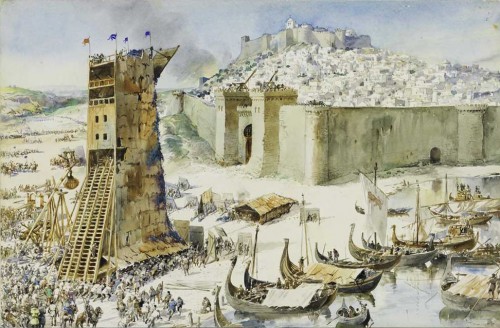
Siege of Lisbon, 1147 CE
Artillery machines were ranged against a target in batteries, and their operators worked in shifts so that a target could be continuously bombarded. English crusaders at the siege of Lisbon in 1147 CE managed to fire off 5000 stones over 10 hours, for example, although this seems exceptional. Modern reconstruction experiments revealed that beam-sling machines could hurl a boulder weighing up to 60 kilograms (130 lbs) over a distance ranging from 85 to 133 metres (100-145 yards). Distance and angle of fire could both be improved by putting a machine on a hill or even a tower, as happened in conflicts in Italian towns where medieval villas often had their own tower. During the siege of Milan in 1158 CE, the Holy Roman EmperorFrederick Barbarossa (r. 1155-1190 CE) mounted a machine on an old Roman arch, although as an open target it was eventually smashed by the defenders own artillery fire.
In the typical siege situation, the range of artillery was not huge and perhaps explains why artillery machines are usually depicted very close to a defensive wall in medieval illustrations and why those operating them needed some form of protection. Archers and crossbowmen could fire with great accuracy and pick off artillery operators. If the defenders had their own artillery, then they would be used to target the attacker's machines. Wooden walls at the front of the machine offered some protection for the operators, but a direct hit from a boulder could easily disable a catapult.
Aside from physical damage, the sight of a battery of artillery machines being assembled in full view must have been a daunting one for those under siege. There were also other strategies besides the brute force of launching heavy objects at the enemy. Henry V of England (r. 1413-1422 CE) famously had dead animals thrown into the wells of Rouen in France during his siege of 1418-19 CE in order to foul the water supply. Catapults might launch manure and corpses in the hope of spreading disease amongst the enemy. In the 15th century CE, there was even the use of sulphur gas to drive the defenders out of their retreat - Pope Alexander VI (r. 1492-1503 CE) was accused of such tactics during the siege of Ostie in 1498 CE.
THE BALLISTA
The ballista was a very large crossbow mounted on its own stand, a design which had been used to good effect by ancient Roman armies. The weapon fired thick wooden arrows or heavy iron bolts with great accuracy. Surviving iron bolt heads from Avignon in France and Hasenburg castle in Switzerland range from 100 to 170 grammes (3.5-6 oz). The bow measured anywhere from one to two metres in length (40-80 inches) and the string was drawn back using a winch. The force of the machine meant that a well-aimed missile could go through two or more men, as is recorded during the Viking siege of Paris in 885-6 CE when one eyewitness described a hapless trio of Danes, shot through with a bolt, as looking like birds on a spit ready to be cooked.

Medieval Ballista
A skilled ballista shooter could pick off imprudent individuals on battlements, and this resulted in wooden shutters being added to fortification walls for extra protection. However, as they were not much use at penetrating stone, ballistas were used more by the defenders as they had the advantage of being more compact than a catapult, and so three could fit into a single floor of a tower. With three floors to a tower, a respectable fusillade of bolts could be reigned down on the enemy. A more powerful version of the ballista was the espringal, which had two separate bow arms pulled back by winched ropes and which could fire large, metal-tipped arrows weighing up to 1.4 kilos (3 lbs) or even stones. Deadly accurate with their sophisticated trigger mechanisms, they were ideal for guarding weak points such as gates.
THE MANGONEL
Catapults or mangonels, as they are sometimes called (although the precise terminology for medieval artillery is confusing with no unanimous agreement - then and now - on what machine should carry which name), were based on ancient designs and widely used from the 11th century CE as European kingdoms came into increasing contact with the Byzantine Empire, the Islamic armies as they entered Spain, and the Avars of Eurasia. The Islamic armies had contact with both India and China, as did the Avars. It is the Chinese who are credited with inventing the mangonel between the 5th and 3rd century BCE. The Roman version, known as an onager, was similar but used animal gut instead of rope to provide the torsion.
MANGONELS LAUNCHED BOULDERS TOWARDS THE MORE FRAGILE CRENELLATIONS (BATTLEMENTS) OF A WALL OR THE MEN STANDING BEHIND THEM.
Quite how the medieval European version of the mangonel was arrived at is much-debated, and different armies likely had their own variations in particulars of design. The standard construction, based on medieval illustrations and descriptions in manuscripts, involved a single arm with an oxhide sling or bucket attached which was sprung by the tension of a twisted rope.The rope was pulled down and so the arm made ready to spring by one or several men (or women in one recorded siege).There were various metal parts of steel, bronze, and iron, but it is not known exactly how or where they were used. Mangonels could launch a boulder towards the enemy but, generally, not one heavy enough to destroy a wall. Their target was, rather, the more fragile crenellations (battlements) of a wall or the men standing behind them. There are some records of small versions being mounted on to a siege tower or on ships when attacking harbour fortifications.
THE TREBUCHET
Trebuchets were a genuine medieval invention and were first seen in Italy in the 12th century CE and used more widely from the 13th century CE, when they are recorded in England, Germany, and France. Probably originating from the Middle East, the confused terminology employed by medieval chroniclers has prevented modern historians from piecing together their exact origin. The first definite mention of a European trebuchet occurs in a chronicle describing the siege of Castelnuovo Bocca d'Adda near Cremona in Italy in 1199 CE.
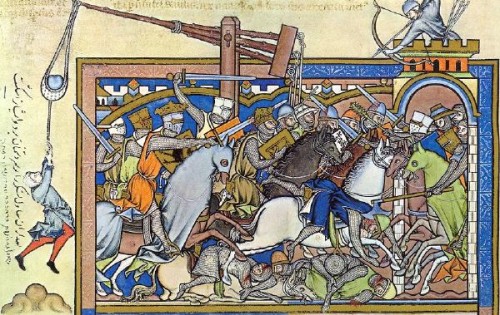
Medieval Trebuchet
A trebuchet used a counterweight (rather than the torsion of a rope like in a mangonel) made from stone or metal plating to spring a single arm and propel a heavy boulder towards the enemy. The arm, attached to a metal axle and greased with animal fat, was wound tense by a winch. Precise designs are difficult to reconstruct, given the lack of remains and often fanciful drawings of medieval historians who had next to no knowledge of engineering. There are some surviving descriptions, one being that of a trebuchet employed by Simon de Montfort during the siege of Toulouse in France in 1218 CE. The machine had a 12-metre (13 yards) long arm and a counterweight of 2.6 tonnes (2,200 lbs).
As they could launch heavier stones than the mangonels and fired them with a higher trajectory, all but the thickest fortification walls were now in danger of being crushed to rubble by the trebuchet. No wonder, then, that many armies christened their machines with names like 'the Bull' or Malvoisin ('bad neighbour'). By the 14th century CE, trebuchets were even bigger and better and equipped with a counterweight of 4.5 to 13.5 tonnes (9,900-29,750 lbs) which could fire a stone weighing anything from 45 to 90 kilos (100-200 lbs). The range was probably around 275 metres (300 yards). The sheer size of these monsters and their complex mechanism is indicated by a record of Edward I of England's (r. 1272-1307 CE) machine at the siege of Stirling in Scotland in 1304 CE which reports that it took 54 carpenters three months to put together. Naturally, defenders of cities and castles employed these machines, too, usually on towers which were often heightened to increase their firing range and even hurling back the same stones that the attackers had fired.
THE CANNON
Gunpowder was probably invented in ancient China and presumably entered Europe via trade routes such as the Silk Road, but its potential as a means to propel a missile at great speed and distance was slow to be realised. Eventually, two brass cannons were being cast in Florence in 1326 CE and the Tower of London had its own cannons in 1338 CE. The earliest depiction of gunpowder artillery is a 1326 CE English manuscript, which shows a cannon on a wooden stand ready to fire a metal bolt. The first recorded European battle where cannons were used was the Battle of Crécy in 1346 CE, where they helped the English defeat a larger French and Genovese army.
LIMITATIONS IN THE WIDESPREAD USE OF CANNONS WERE THE SHEER COST OF PRODUCING THEM & ACQUIRING A SUFFICIENT SUPPLY OF GUNPOWDER.
Such early firearms, sometimes known as bombards, were first made from bronze or copper, and then, from c. 1370 CE, iron strips forged into cylinders. They fired either small balls or bolts made of wood with an iron head (garrots). Early versions were usually more lethal to the people firing them than the target; such was the lack of knowledge and design know-how of the medieval period in this area. James II of Scotland (r. 1437-1460 CE), for example, was killed by an exploding cannon in the 1460 CE siege of Roxburgh. Other limitations on their widespread use were the sheer cost of producing them, acquiring a sufficient supply of gunpowder, finding men with the skill to fire them accurately, and being able to move the cumbersome things to where they were needed in battle. Smaller cannons could be mounted on carts, but bigger ones were too big to move around easily, with wheeled and elevated carriages only in common use from the 15th century CE. One of the largest cannons produced was the Mons Meg cannon, made, again, for James II of Scotland in 1449 CE (clearly a tragic fan of the weapon), which could fire stone balls measuring 48 cm (19 inches) across and weighing 180 kilos (400 lbs) over a distance of around 250 metres (275 yards). This giant iron cannon may be seen today on permanent display at Edinburgh Castle.
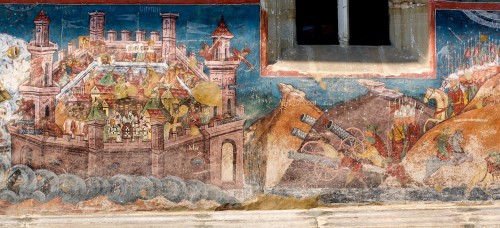
The Siege of Constantinople
Small firearms - basically handheld cannons weighing up to 15 kilos (33 lbs) - were used from the 14th century CE, probably introduced by Arab armies. More accurate handguns, which fired small balls, bolts, or lead pellets, were in use from the 15th century CE and were known as an arquebus or hackbut. New versions of metal body armour were even tested by firing such guns at close range.
A 1461 CE inventory of Caister castle in England reveals the presence of a handy collection of gunpowder weapons of various calibres. There were four breach-loading guns with eight chambers. Two of the guns could fire 15 cm (7 in) stone balls, and the other two fired 12 cm (5 in) stone balls. There was also a serpentine cannon (the smallest type), which was loaded with 25 cm (10 in) stone and a smaller one fired a 15 cm stone. There were three fowlers (a name for smaller types of cannon), which fired 30 cm stones, six smaller cannons which fired lead pellets, and seven handguns.
Unsurprisingly, walls were thickened and heightened as a response to the threat of cannons and defenders could, of course, have their own, which saw windows altered accordingly in many fortifications to give a greater arc of fire. These cannon ports had a round aperture for the cannon and a vertical slit window above for sighting, hence their common name of 'keyhole windows'. Towers and walls were sometimes lowered, too, to give a better firing platform from which to bombard the attackers if the castle had its own cannons. However, it was in attack that cannons were used with the greatest effect as warfare became more aggressive and dynamic. Cannons also became more accurate in the 15th century CE when the benefit was realised of drilling out the barrel with a steel bit to make it smoother.
Early cannons had fired stone balls which were cut for the purpose, but from the 15th century CE, cannons fired cast iron balls, and one of the most dramatic adverts for their use was the 1453 CE siege of Constantinople by Ottoman Sultan Mehmed II (r. 1444-6 & 1451-81 CE), whose army fielded 62 cannons. Cannons were also a decisive factor in the French victory of the Hundred Years War (1337-1453 CE) against England. When in the 15th century CE batteries of huge cannons were being more widely used, which fired balls weighing over 100 kilos (220 lbs), the days of static siege warfare effectively came to an end as no fortifications could resist a barrage of such cannon fire for very long. In addition, when firearms overcame the early problems of inaccuracy and slow loading time, their obvious advantages in penetration and the lack of skill needed to fire them compared to such traditional weapons as the longbow meant that the gun changed warfare completely just as the medieval period was coming to a close.
LICENSE:
Article based on information obtained from these sources:with permission from the Website Ancient History Encyclopedia
Content is available under License Creative Commons: Attribution-NonCommercial-ShareAlike 3.0 Unported. CC-BY-NC-SA License